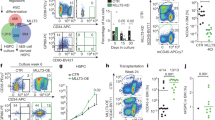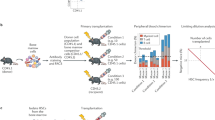Abstract
A central issue in stem cell biology is to understand the mechanisms that regulate the self-renewal of haematopoietic stem cells (HSCs), which are required for haematopoiesis to persist for the lifetime of the animal1. We found that adult and fetal mouse and adult human HSCs express the proto-oncogene Bmi-1. The number of HSCs in the fetal liver of Bmi-1-/- mice2 was normal. In postnatal Bmi-1-/- mice, the number of HSCs was markedly reduced. Transplanted fetal liver and bone marrow cells obtained from Bmi-1-/- mice were able to contribute only transiently to haematopoiesis. There was no detectable self-renewal of adult HSCs, indicating a cell autonomous defect in Bmi-1-/- mice. A gene expression analysis revealed that the expression of stem cell associated genes3, cell survival genes, transcription factors, and genes modulating proliferation including p16Ink4a and p19Arf was altered in bone marrow cells of the Bmi-1-/- mice. Expression of p16Ink4a and p19Arf in normal HSCs resulted in proliferative arrest and p53-dependent cell death, respectively. Our results indicate that Bmi-1 is essential for the generation of self-renewing adult HSCs.
This is a preview of subscription content, access via your institution
Access options
Subscribe to this journal
Receive 51 print issues and online access
$199.00 per year
only $3.90 per issue
Buy this article
- Purchase on Springer Link
- Instant access to full article PDF
Prices may be subject to local taxes which are calculated during checkout





Similar content being viewed by others
References
Morrison, S. J. & Weissman, I. L. The long-term repopulating subset of hematopoietic stem cells is deterministic and isolatable by phenotype. Immunity 1, 661–673 (1994)
van der Lugt, N. M. et al. Posterior transformation, neurological abnormalities, and severe hematopoietic defects in mice with a targeted deletion of the bmi-1 proto-oncogene. Genes Dev. 8, 757–769 (1994)
Ramalho-Santos, M. et al. ‘Stemness’: transcriptional profiling of embryonic and adult stem cells. Science 298, 597–600 (2002)
Park, I.-K. et al. Molecular cloning and characterization of a novel regulator of G-protein signaling from mouse hematopoietic stem cells. J. Biol. Chem. 276, 915–923 (2001)
Park, I. K. et al. Differential gene expression profiling of adult murine hematopoietic stem cells. Blood 99, 488–498 (2002)
Lessard, J., Baban, S. & Sauvageau, G. Stage-specific expression of Polycomb group genes in human bone marrow cells. Blood 91, 1216–1224 (1999)
Kiyono, T. et al. Both Rb/p16INK4a inactivation and telomerase activity are required to immortalize human epithelial cells. Nature 396, 84–88 (1998)
van der Lugt, N. M. T., Alkema, M., Berns, A. & Deschamps, J. The Polycomb-group homolog Bmi-1 is a regulator of murine Hox gene expression. Mech. Dev. 58, 153–164 (1996)
Akashi, K. et al. Transcriptional accessibility for genes of multiple tissues and hematopoietic lineages is hierarchically controlled during early hematopoiesis. Blood 101, 383–389 (2003)
Morrison, S., Hemmati, H., Wandycz, A. & Weissman, I. The purification and characterization of fetal liver hematopoietic stem cells. Proc. Natl Acad. Sci. USA 92, 10302–10306 (1995)
Wright, D. E. et al. Hematopoietic stem cells are uniquely selective in their migratory reponse to chemokines. J. Exp. Med. 195, 1145–1154 (2002)
Mahmoudi, T. & Verrijzer, C. P. Chromatin silencing and activation by Polycomb and trithorax group proteins. Oncogene 20, 3055–3066 (2001)
Weber, J. D. et al. Nucleolar Arf sequesters Mdm2 and activates p53. Nature Cell Biol. 1, 20–26 (1999)
Jacob, J. et al. The oncogene and Polycomb-group gene bmi-1 regulates cell proliferation and senescence through the ink4a locus. Nature 397, 164–168 (1999)
Quelle, D. E., Zindy, F., Ashmun, R. A. & Sherr, C. J. Alternative reading frames of the INK4a tumour suppressor gene encode two unrelated proteins capable of inducing cell cycle arrest. Cell 84, 993–1000 (1995)
Antonchuk, J., Sauvageau, G. & Humphries, R. K. HOXB4 overexpression mediates very rapid stem cell regeneration and competitive hematopoietic repopulation. Exp. Hematol. 29, 1125–1134 (2002)
Lawrence, H. J. et al. Mice bearing a targeted interruption of the homeobox gene HOXA9 have defects in myeloid, erythroid, and lymphoid hematopoiesis. Blood 89, 1922–1930 (1997)
Christensen, J. L. & Weissman, I. L. Flk-2 is a marker in hematopoietic stem cell differentiation: a simple method to isolate long-term stem cells. Proc. Natl Acad. Sci. USA 98, 14541–14546 (2001)
Zhang, Y., Xiong, Y. & Yarbrough, W. G. ARF promotes MDM2 degradation and stabilizes p53: ARF-INK4a locus deletion impairs both the Rb and p53 tumour suppression pathways. Cell 92, 725–734 (1998)
Shivdasani, R., Mayer, E. & Orkin, S. Absence of blood formation in mice lacking the T-cell leukaemia oncoprotein tal-1/SCL. Nature 373, 432–434 (1995)
Porcher, C. et al. The T cell leukemia oncoprotein SCL/tal-1 is essential for development of all hematopoietic lineages. Cell 86, 47–57 (1996)
Antonchuk, J., Sauvageau, G. & Humphries, R. K. HOXB4-induced expansion of adult hematopoietic stem cells ex vivo. Cell 109, 39–45 (2002)
Domen, J., Cheshier, S. H. & Weissman, I. L. The role of apoptosis in the regulation of hematopoietic stem cells: overexpression of BCL-2 increases both their number and repopulation potential. J. Exp. Med. 191, 253–264 (2000)
Nichogiannopoulou, A. et al. Defects in hemopoietic stem cell activity in Ikaros mutant mice. J. Exp. Med. 190, 1201–1214 (1999)
Fisher, R. C., Lovelock, J. D. & Scott, E. W. A critical role for PU.1 in homing and long-term engraftment by hematopoietic stem cells in the bone marrow. Blood 94, 1283–1290 (1999)
Cheng, T. et al. Hematopoietic stem cell quiescence maintained by p21cip1/waf1. Science 287, 1804–1808 (2000)
Ohta, H. et al. Polycomb group gene rae28 is required for sustaining activity of hematopoietic stem cells. J. Exp. Med. 195, 759–770 (2002)
Pear, W., Nolan, G., Scott, M. & Baltimore, D. Production of high-titer helper-free retroviruses by transient transfection. Proc. Natl Acad. Sci. U.S.A. 90, 8392–8396 (1993)
Cotta, C., Swindle, C., Weissman, I. L. & Klug, C. A. Retroviral Transduction of FACS-Purified Hematopoietic Stem Cells (eds Klug, C. A. & Jordan, C. T.) 243–252 (Humana Press, Totowa, New Jersey, 2001)
Lessard, J. & Sauvageau, G. Bmi-1 determines the proliferative capacity of normal and leukaemic stem cells. Nature advance online publication, 20 April 2003 (doi: 10.1038/nature01572)
Acknowledgements
We thank T. Magnuson and C. Klug for providing Bmi-1+/- mice and the MSCV plasmid, respectively; and the Flow Cytometry Core and the Microarray Core at the University of Michigan for their work. The Microarray Core is supported in part by a University of Michigan's Cancer Center Support Grant from the NIH. This work is supported by grants from the NIH.
Author information
Authors and Affiliations
Corresponding author
Ethics declarations
Competing interests
The authors declare that they have no competing financial interests.
Supplementary information
Rights and permissions
About this article
Cite this article
Park, Ik., Qian, D., Kiel, M. et al. Bmi-1 is required for maintenance of adult self-renewing haematopoietic stem cells. Nature 423, 302–305 (2003). https://doi.org/10.1038/nature01587
Received:
Accepted:
Published:
Issue Date:
DOI: https://doi.org/10.1038/nature01587
This article is cited by
-
Acute lymphoblastic leukemia in children and SALL4 and BMI-1 gene expression
Pediatric Research (2023)
-
Childhood hematopoietic stem cells constitute the permissive window for RUNX1-ETO leukemogenesis
International Journal of Hematology (2023)
-
Inhibition of the immunoproteasome modulates innate immunity to ameliorate muscle pathology of dysferlin-deficient BlAJ mice
Cell Death & Disease (2022)
-
Nuclear Vav3 is required for polycomb repression complex-1 activity in B-cell lymphoblastic leukemogenesis
Nature Communications (2022)
-
Less BMI-1 is more for chronic infections
Nature Immunology (2022)
Comments
By submitting a comment you agree to abide by our Terms and Community Guidelines. If you find something abusive or that does not comply with our terms or guidelines please flag it as inappropriate.



